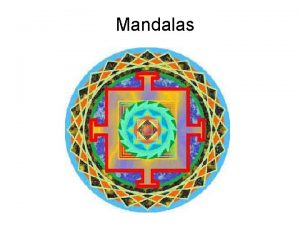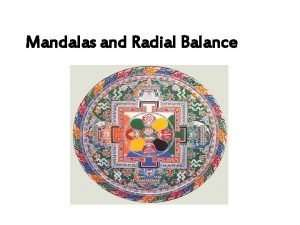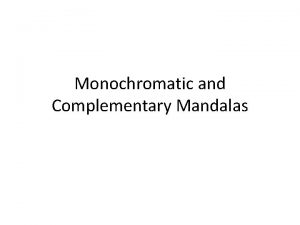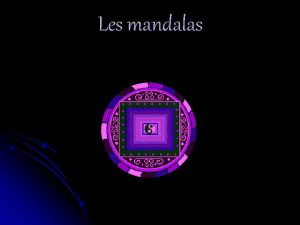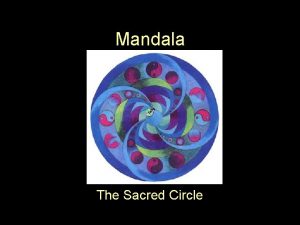Mandalas What are Mandalas The word mandala originates
























- Slides: 24

Mandalas

What are Mandalas? The word mandala originates from the classical Indian language of Sanskrit. It loosely translates to mean “circle” however a mandala is far more than a simple shape.

A mandala can be described as any form of circular geometric design that contains symbols of a person’s inner self, guiding principles, and overall ideas about the world. It is a symbol of wholeness and can be seen as a representation of life itself.

The significance of objects within a mandala are conveyed by shape, size, and color; they can be abstract designs or specific images of people, places, and ideas that are central to a person’s life.

The Mandala in Nature From micro to macro: The "circle with a center“ pattern is the basic structure of creation that is reflected throughout nature in the world as we know it. ØOn our planet, living things are made of cells and each cell has a nucleus -- all display circles with centers. The crystals that form ice, rocks, and mountains are made of atoms. Each atom is a mandala.

The Mandala in Nature ØWithin the Milky Way galaxy is our solar system and within our solar system, is Earth. Each is a mandala that is part of a larger mandala.

The Mandala in Nature ØFlowers, the rings found in tree trunks and the spiraling outward and inward of a snail's shell all reflect the primal mandala pattern. Wherever a center is found radiating outward and inward, there is wholeness--a mandala.


Types of Mandalas In the Americas, Indians have created medicine wheels and sand mandalas. The circular Aztec calendar was both a timekeeping device and a religious expression of ancient Aztecs. In Asia, the Taoist "yin-yang" symbol represents opposition as well as interdependence. Tibetan mandalas are often highly intricate illustrations of religious significance that are used for meditation.


Balance refers to the distribution of visual weight in a work of art. Radial Balance: image is emerging from a central point of location and equally weighted around the entire piece. Radial Balance

Symmetrical Balance: Elements are given equal weight from an imaginary line in the center of a piece of artwork. Symmetrical Balance

Asymmetrical Balance: having an uneven distribution of parts throughout a composition. Asymmetrical Balance


Organic Lines

Organic Lines Organic, free formed, natural looking lines – They are derived from nature

Geometric Lines

Geometric Lines Straight, angular, precise man made looking lines.






 Antigentest åre
Antigentest åre What is mandalas
What is mandalas Mandalos spalvinimui
Mandalos spalvinimui History of mandalas
History of mandalas A land breeze usually originates during the ____.
A land breeze usually originates during the ____. The view that knowledge originates in experience
The view that knowledge originates in experience Types of pathogens
Types of pathogens Word mandala
Word mandala Thế nào là mạng điện lắp đặt kiểu nổi
Thế nào là mạng điện lắp đặt kiểu nổi Dạng đột biến một nhiễm là
Dạng đột biến một nhiễm là Nguyên nhân của sự mỏi cơ sinh 8
Nguyên nhân của sự mỏi cơ sinh 8 Bổ thể
Bổ thể Vẽ hình chiếu đứng bằng cạnh của vật thể
Vẽ hình chiếu đứng bằng cạnh của vật thể độ dài liên kết
độ dài liên kết Môn thể thao bắt đầu bằng chữ f
Môn thể thao bắt đầu bằng chữ f Thiếu nhi thế giới liên hoan
Thiếu nhi thế giới liên hoan Sự nuôi và dạy con của hươu
Sự nuôi và dạy con của hươu Chúa yêu trần thế
Chúa yêu trần thế điện thế nghỉ
điện thế nghỉ Một số thể thơ truyền thống
Một số thể thơ truyền thống Trời xanh đây là của chúng ta thể thơ
Trời xanh đây là của chúng ta thể thơ Các số nguyên tố là gì
Các số nguyên tố là gì Tỉ lệ cơ thể trẻ em
Tỉ lệ cơ thể trẻ em Phối cảnh
Phối cảnh Các châu lục và đại dương trên thế giới
Các châu lục và đại dương trên thế giới


























